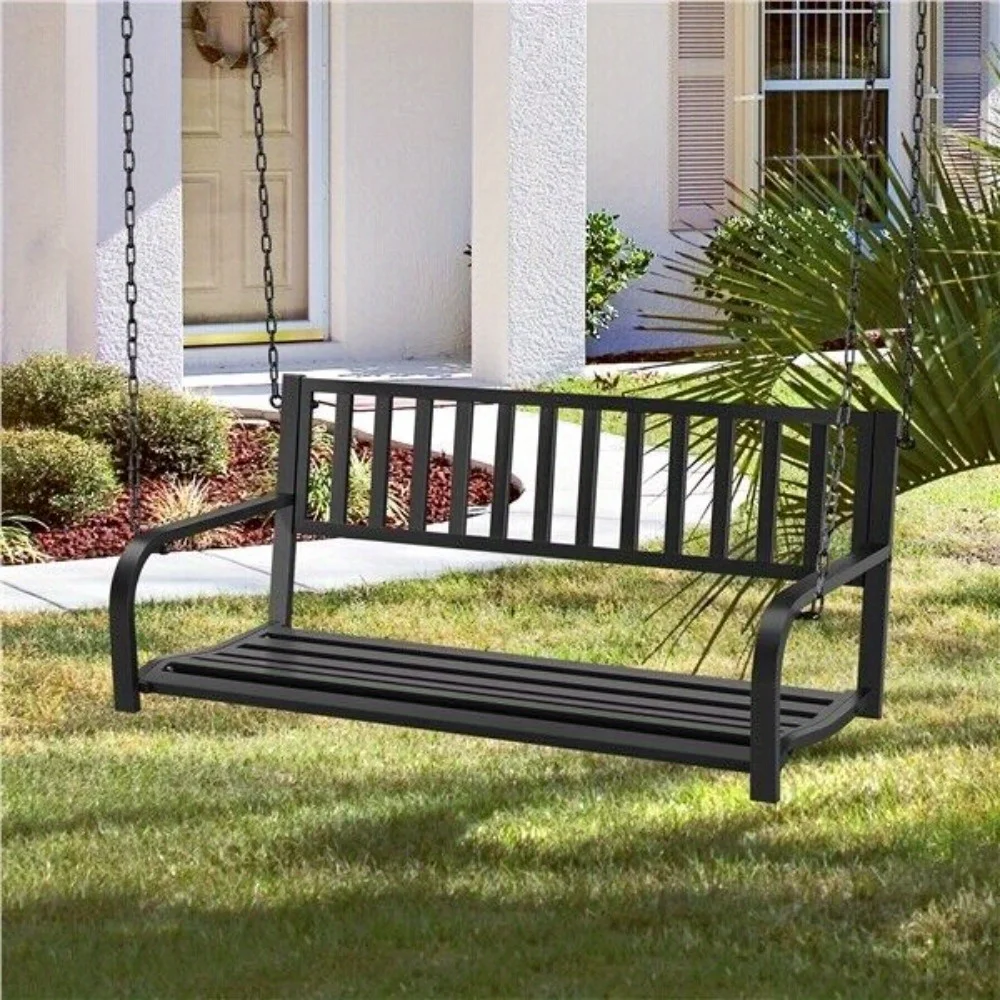Choosing the Perfect Porch Swing
Selecting the ideal porch swing is more than just picking a design you like. It involves taking into account several key factors to ensure that it will fit your space, match your home’s aesthetic, and offer the comfort and durability you desire. Here’s how to navigate these considerations.
Considerations for Size, Material, and Style
Firstly, measure your porch to determine the appropriate swing size. A common mistake is to choose a swing that overwhelms or underutilizes the available space. Typically, porch swings range from four to six feet in length. Ensure there is ample room for the swing to move freely without hitting railings or walls.
The material of the porch swing affects its look, durability, and maintenance needs. Popular materials include wood, wicker, metal, and plastic, each with its pros and cons. Wood offers a classic appearance but requires regular upkeep. Metal is sturdy and long-lasting, while plastic provides minimal maintenance but may lack the charm of other materials.
Style-wise, the swing should complement your home’s exterior. Classic slatted wood swings lend a timeless feel, whereas wicker can offer a cozy, Bohemian touch. Modern homes may benefit from sleek metal designs. Always consider how the swing will blend with your outdoor decor.

Weight Capacity and Ensuring Safety
It’s crucial to verify the weight capacity of your porch swing to ensure it can support the intended users safely. Overloading the swing can pose a risk and potentially damage your porch’s structure.
To promote safety, check that the swing’s chains or ropes are robust and weather-resistant. The swing’s attachments should firmly secure to the porch’s support beams, not just the ceiling material. If you’re uncertain about the weight capacity or correct installation methods, it might be wise to consult with a professional.
When you know how to install a porch swing while considering these factors, you’ll be able to choose the perfect one for your home and enjoy it safely for years to come.
Necessary Tools and Materials
Before starting your porch swing installation, gathering the right tools and materials is essential. This preparation ensures a smooth installation process and a secure final product.
List of Tools Needed for Installation
- Tape Measure – Measure the porch area to fit the swing accurately.
- Level – Ensure the swing hangs evenly.
- Drill – For making pilot holes for the hooks or hangers.
- Socket Set – Tighten nuts and bolts securely.
- Adjustable Wrench – Useful for various hardware adjustments.
- Ladder – Reach higher installation points safely.
- Hammer – Assist in securing any additional support.
Choosing to prepare these tools beforehand will prevent unnecessary interruptions during installation.
Selecting Durable Hardware for Your Swing
The longevity of your porch swing largely depends on the quality of the hardware used. Options to consider include:
- Stainless Steel Hooks or Hangers: Ideal for rust resistance and strength.
- Heavy-Duty Chains or Ropes: Ensure they can support the weight capacity.
- Lock Nuts and Washers: Help in securely fixing components.
Choosing hardware designed for outdoor use ensures durability and safety. Always check that the load rating of the hardware exceeds the combined weight of the swing and its users.
Pre-Installation Preparation
Before drilling any holes or hanging a porch swing, proper pre-installation preparation is crucial. This stage includes identifying the best spot for your swing and making sure your porch has the structural support to hold it.
Identifying and Marking the Swing’s Location
Choosing the right location for your swing is the first step in the pre-installation process. You want a spot that allows for at least 2-3 feet of clearance from walls or railings for a gentle sway. Use your tape measure to find the ideal distance and mark the points where the swing will hang. These marks will guide you when it’s time to drill.
It’s also essential to consider the direction of the swing. For relaxation and the best view, position the swing to face your yard or garden. Once you’ve decided on the location, use chalk or painter’s tape to outline where the swing will go. This visual aid helps ensure accuracy during installation.

Understanding Your Porch’s Structural Support
An often overlooked aspect of how to install a porch swing is assessing the structural support of your porch. The swing’s weight, along with that of its occupants, demands sturdy support for safe use. Locate the load-bearing beams overhead, typically where you should anchor the swing’s hardware. If you’re unsure, consult a professional to help identify these beams.
It’s better to be safe than sorry when dealing with potential structural issues. A professional can also advise whether additional reinforcement is necessary. By understanding the structural integrity of your porch, you can install your swing with confidence, knowing that it is well-supported for years of enjoyment.
Attaching the Swing Hardware
After preparing your porch and gathering the necessary supplies, it’s time to attach the hardware. This step is pivotal for the safety and stability of your porch swing.
Installing Eye Bolts or Swing Hangers
Begin by drilling pilot holes at the marked spots on your porch’s load-bearing beams. Ensure these holes align with the marks made during the pre-installation phase. Once the holes are ready, twist the eye bolts or swing hangers into place. If using eye bolts, secure them with washers and nuts, tightening firmly with your wrench. Swing hangers typically come with mounting plates for additional support, so make sure these are attached flush against the beam. Always double-check that these fixtures are fastened tightly, as they will bear the full weight of the swing and its occupants.
Securing Chains or Ropes for Your Swing
With the eye bolts or hangers installed, attach your porch swing’s chains or ropes. Start by connecting the upper ends to the hardware you’ve just installed. Adjust the chains or ropes so they are even and the swing will hang at the desired height. At this point, don’t attach the lower ends to the swing yet. This allows for adjustment and ensures the chains or ropes are not twisted. Use a level to confirm that the swing will hang evenly once installed. Only after making these adjustments should you connect the chains or ropes to the swing itself. Confirm that all fastenings are secure and there is no risk of slippage. Now, your porch swing is securely attached and almost ready for use.
In these steps, making sure everything is level and evenly spaced is crucial. Proper installation ensures a long-lasting and safe swing experience. Checking each connection twice will save you time and add peace of mind about the security of your porch swing.
Hanging the Porch Swing
After securing the hardware, you’re ready to hang the porch swing. This is where precision matters to get a level and stable swing.
Steps for Ensuring a Level and Stable Swing
- Link the chains or ropes: Connect each chain or rope to the corresponding eye bolt or swing hanger.
- Use a level: Place a level on the seat of the swing to check that it is horizontally even.
- Adjust as needed: If the swing is not level, adjust the length of the chains or ropes until it is.
- Test the stability: Gently push the swing to ensure it moves smoothly and stays level.
These steps are essential for a swing that’s safe and comfortable to use.

Safety Checks Before the First Use
Before you sit on the swing, conduct these safety checks:
- Inspect the hardware: Look at all bolts, nuts, and chains to confirm they’re tight and undamaged.
- Check weight capacity: Gently apply pressure to test if the swing can hold the expected weight.
- Look for obstacles: Ensure the swing path is clear of any objects that could cause harm.
- Final inspection: Give one last visual check to all parts of the swing and hardware.
Following these safety checks will help prevent accidents and ensure your porch swing is a safe place to relax.
Adjusting and Customizing Your Swing
Once your porch swing is up, you might need to make minor adjustments. Customizing ensures comfort and aligns with your stylistic preferences.
Fine-Tuning Chain or Rope Length
Adjust the chain or rope length for an ideal seat height. Sit on the swing and check that your feet touch the ground comfortably. If not, shorten or lengthen the chains or ropes until you achieve the desired height. Ensure both sides are even to maintain a level swing.
Remember to keep the height accessible for all users. Use a ladder to reach the hardware if needed, and always double-check the adjustments. This way, everyone can enjoy the swing at a safe and comfortable level.
Adding Accessories for Comfort and Style
Accessories can boost both comfort and curb appeal. Consider adding cushions for a soft seat. Choose weather-resistant fabrics that match your home’s color scheme.
Adding pillows provides extra support and a pop of color. Install a side table nearby to hold drinks or a book. For evening use, hang string lights for a cozy ambiance. With these touches, your porch swing will be the perfect comfort spot.
By fine-tuning and accessorizing your porch swing, you’re enhancing the overall experience. Keep personal preference and safety in mind during this process. Now, get ready to enjoy your personalized relaxation oasis.
Maintenance and Care Tips
After completing the installation of your porch swing, it’s vital to maintain it properly. Regular maintenance ensures a safe, comfortable swing that lasts years.
Regular Inspection and Upkeep
Be proactive with inspection and maintenance for longevity. Check metal parts for rust or wear. Look at wood for splinters or cracks. Tighten any loose bolts and nuts. Oil any squeaky chains or moving parts. Clean the swing often, using materials safe for your swing’s makeup. Always fix issues as soon as they arise.
For wood swings, consider re-staining or sealing every few years. This upkeep prevents damage from the elements. Remember to check the weight limit before each use and inspect it throughout the year.
Seasonal Considerations for Porch Swings
Porch swings face different weather throughout the year. In winter, cover wooden swings or store them inside to prevent weather damage. During rainy seasons, ensure proper drying to prevent mold and rot.
In summer, check for sun damage like fading or cracking. For high heat resistance, consider UV-protective coatings. Always clear snow or leaves to avoid excess moisture accumulation. These steps help keep your swing safe and looking great all year round.
